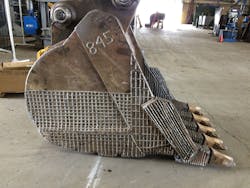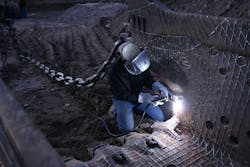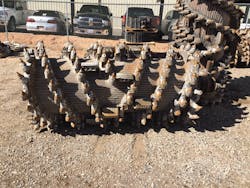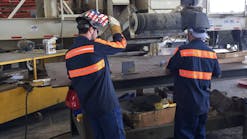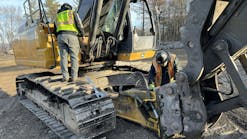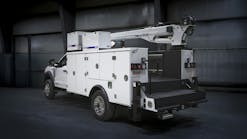It’s the level of abrasion, the desired wear life, and the cost of new ground-engaging tools that determine whether hard facing is a maintenance option for extended life of these tools.
“When you apply an alloyed material to a metal part, it produces a protection or shield against abrasion accompanied by impact, abrasion accompanied by corrosion, abrasion accompanied by heat, or abrasion accompanied by any combination of these factors,” says John Lopez, regional alloy sales specialist for Lincoln Electric.
“But the key word is abrasion. Unless you have abrasion as one of the factors for a part wearing away, you shouldn’t be using hard facing product.”
Specifically, Lopez says the most common culprits are metal-to-earth abrasion with moderate impact, and metal-to-metal wear. And smaller attachments are not exempt.
“We’re recycling automobiles, wood waste, washers, dryers, glass, car batteries, tires; we live in a world where we throw everything away, and these items are all shredded up and recycled,” he says. “You’ve got all these different tools such as hammers, shredders, and knives that shred all this material. So when these parts wear, they need to be built back up and hard faced to prolong the life of that equipment.”
Lopez says the first factor in determining how much extended life can be added is the environment. “North Carolina, where the dirt is a red clay, is a little different than working in Florida, where you have sand that’s more abrasive, or in Hawaii, with a lot of coral rock,” he says.
“It depends on the conditions you’re working in, but usually you can expect from four to 10 times more life, in some cases even greater than that.”
Craig Turner, wear parts market professional for Caterpillar, also focuses on squeezing more out of the investment. “The bare plate steel or casting is a great foundation, but sometimes with the way the machine operates, or an operator’s technique, it doesn’t allow you to consume that plate steel or that casting to its maximum benefit,” he says.
“What we recognize with our customers for overlay, or hard facing, is that it’s a great product that can help you control and direct both the rate and the directions of wear,” Turner says. “If you can invest 10 or 20 percent in an overlay, a hard facing product, and get three to five times life, that’s a pretty good value, as long as your environment allows you to apply that without being chipped, or broken.”
How welding professionals use hard facing
The equipment technicians’ use for hard facing, and the technique, can vary based on the site of the work (shop versus field) and the metals involved.
“Usually people use a coated electrode [arc welding], or they use a Mig welder, for Mig welders using tubular wires,” Lopez says. “In my market [California], I’m seeing a lot more people gravitating from electrodes to wires, because of the cost savings. It can be applied a lot quicker. Using an electrode, you can only weld so far. You weld all the way down to a stub-end. When you weigh all those stub-ends at the end of the week, you’ll find that you’re throwing away a lot of money. Using tubular wires is a lot more productive and cost effective.”
Lopez says that extended life and saving money on consumables are not the only considerations. “We’re talking man hours,” he says. “If they can do it faster, they’re saving money. The faster they can apply, the company can save a lot of money.
“We have two ways of applying it on with our tubular wires,” Lopez says. “If you use a gas shielding, and I recommend using a gas shielding in a confined area like inside a building where you can keep the smoke level down, it will flow much better, it will prolong the life of the contact tip and keep the gun cooler as you’re welding.”
Out in the field, the welding technician can’t always drag a cylinder around and use a gas shielding. “They must have a hard facing product that does not require a gas. I call that open-arc welding,” Lopez says. “Lincoln has build up and hard facing wires for either/or, with or without a gas shielding.”
Kodi Welch, welding engineer, Miller, says larger hard facing jobs will dictate more robust equipment. “The capacity or amperage class may vary [to the size of the job], because some wires can be large in size, so you’ve got to have a power source that is appropriate to whatever the amperage requirements are for the wires being used,” he says. “It may be larger wire for a bigger bucket if they have to put down more material, say on a big loader bucket. I think 7/64ths is one of the largest wires we take calls on here.”
How to hard face a bucket
When it comes to hard facing a bucket, the most common patterns are a waffle (square) or a diamond pattern.
“Is one better than the other? No,” Lopez says. “But the rule of thumb is to have a gap of 1.5 to 1.75 inches so you can trap dirt. The idea of creating a waffle pattern is that dirt will get trapped in that crevice, so you’ll have dirt wearing on dirt, which will prolong the life.”
Added metal and the material being excavated can combine for a protection “team.”
“The patterns depend on the soils the tool is being used in,” Welch says. “Some of the guys in real rocky stuff, they’re going to recommend patterns or lines that are parallel to the direction of wear. They’re going to run more longitudinal lines in the direction the bucket is traveling. Guys that are in more sandy material or more dirt than rock, they’re usually going to run more across the direction of travel to help trap the dirt in between the layers of the hard facing. Operators that are in both of them, they may use a cross hatch- or herringbone-type pattern.”
Common hard facing mistakes
Lopez says he sees two common mistakes in hard facing. “No. 1 is running too big of a waffle or diamond pattern. They apply the pattern too large and they think they’re going to save money, but at 3 or 4 inches, they’re not trapping any dirt.
“The second mistake I see is running too hot on amperage and voltage—then you have flat or concave weld beads,” Lopez says. “You want to apply hard facing as cold as you can with very little dilution. All we’re doing is putting a protective coating onto a metal part, so you want to have convex beads to help trap dirt.”
Techs should strive for both proper dimension and depth. Having two layers of alloy is also important.
“The first time, you’re applying it onto a metal part and you’re picking up what they call dilution; you’re mixing the soft parent metal with the hard facing hard metal, so you dilute the two,” Lopez explains.
“By piggybacking another layer on top of it, that is where you’ll get the true chemistry, the full wear you need,” he says.
“Most guys, if it’s something out of the ordinary, do a pretty good job of researching what they’re going to put on their part,” Miller’s Almy says. “If there’s any common mistake, it would be that they’ll go to the tool crib and pick up an electrode or a wire that they’ve used on something before, or that’s common to them, and it won’t be right for what they’re doing.”
What materials to use in hard facing
Managers should pay special attention to the materials that go into layering.
“When you’re doing hard facing, where you have to do a build-up before the hard facing is actually laid on there, it’s really recommended that you use an alloy to build up the material first,” Welch says. “That’s not necessarily a mild steel, like a 7018; usually they’re going to recommend you use something that’s an actual buildup alloy that’s going to be tougher and harder than the mild steel 7018, but maybe not as tough and hard as what you’re going to end up using for your final layer. “So, the hard facing initially takes its shock, it’s being moved on, but the base alloys under there are tough enough that they can take it, too, without distorting the metal that’s supporting that hard facing layer,” Welch says.
“There’s not always support layers used, because it depends on what a guy’s doing,” Welch continues. “Usually, guys that are doing buckets, they’re going to start hard facing over some of that stuff, but if I had to do a buildup on a tooth or something similar, I’m not just going to build it up to size with 7018 and hard face around it. I may use a build-up alloy between the tooth and that hard face so it can take some of that load better than softer 7018.”
How many times can the same tool be hard faced?
That’s a question with a lot of variables, according to Welch.
“There’s a limit depending on the alloys you’re using on the actual buildup material, if you want to use them like the manufacturers are going to tell you,” Welch says. “If I’m building something up, I’m not going to want to put a lot of layers of chrome carbide on there and not stack too many of those layers on top of each other. And if the hard facing wears off, as long as I can still get in and build up with a buttering layer and put hard facing over it, I can still do that until maybe the teeth are so worn down it’s not worth the time and material it takes to build the tooth back up.
“You may not want to put too many passes of hard facing wire on there because it could make the beads beneath more prone to cracking because they could be brittle,” Welch says.
Lincoln’s Lopez recommends that, when a part is rebuilt, it should be hard faced afterward to extend the life of that part yet again. “Just recently, we were working on a dozer that came from Vietnam, from the Vietnam War days. The dozer blade was still being used and had been rebuilt over and over again,” he says. “I guess they used to clear the jungles with it, and they brought it back to the U.S. Sometimes, you can [rebuild and hard face] equipment for many, many years. It’s a matter of a skilled welder and the right materials.”
Welch urges managers not to rule out hard facing as a preventive measure. “I wouldn’t be afraid to start hard facing on something new, if I knew it was a metal that wasn’t going to hold up very well in really abrasive, rocky soils,” Welch says. “I might start hard facing on a brand new bucket right out of the gate, just to help prolong that life.”
Another strategy for extending life is welding a wear pad onto a bucket or cutting tool.
“You can weld on an AR400 or 500 abrasion-resisting plate,” Welch says.
“It might be a 6-inch square, with a hole in the center of it,” Almy says. “That hole has a similar benefit to a cross hatch; there’s the hard surface, but also dirt gets in that hole and helps wear resistance. It’s a layer of dirt for the other dirt to ride on.”
It’s important to note that wear-plate welding is not a structural welding application. “A lot of times 7018 ductile welds are recommended so you don’t have cracking issues when you weld the wear plate on,” Welch says. “You don’t want hard welds because those will be brittle on your wear plate. You want a weld that will be able to move and give a little bit. Ductile, not brittle. It’s taking impacts and is less likely to crack. When you make the weld and it’s cooling, it’s going to be more ductile and forgiving so it doesn’t cause cracking in the weld when you put the plate on.”
“Applying an AR plate versus hard facing is a matter of what you’re doing and how big you want to do it,” Almy says.
Caterpillar’s Turner says some of his dealers offer wear analysis to help customers make the hard facing decision.
“We look at how that bucket or blade actually wears in the field, so we would use either physical measurements and techniques or we can do a three-dimensional scan,” he says. “Whether that’s from a high-end scanner that would re-create the entire geometery or something simple that can be done from an iPad where we re-create that geometry with no-dimensional properties, in either case, we understand how that parent product was created and we overlay that with the scans to determine if we’re getting the best use out of that tip. This can then lead us to decide if we should apply an overlay to the tip, if so what and where, to better consume the parent part. We can also determine if a new tip is the more effective course.”
